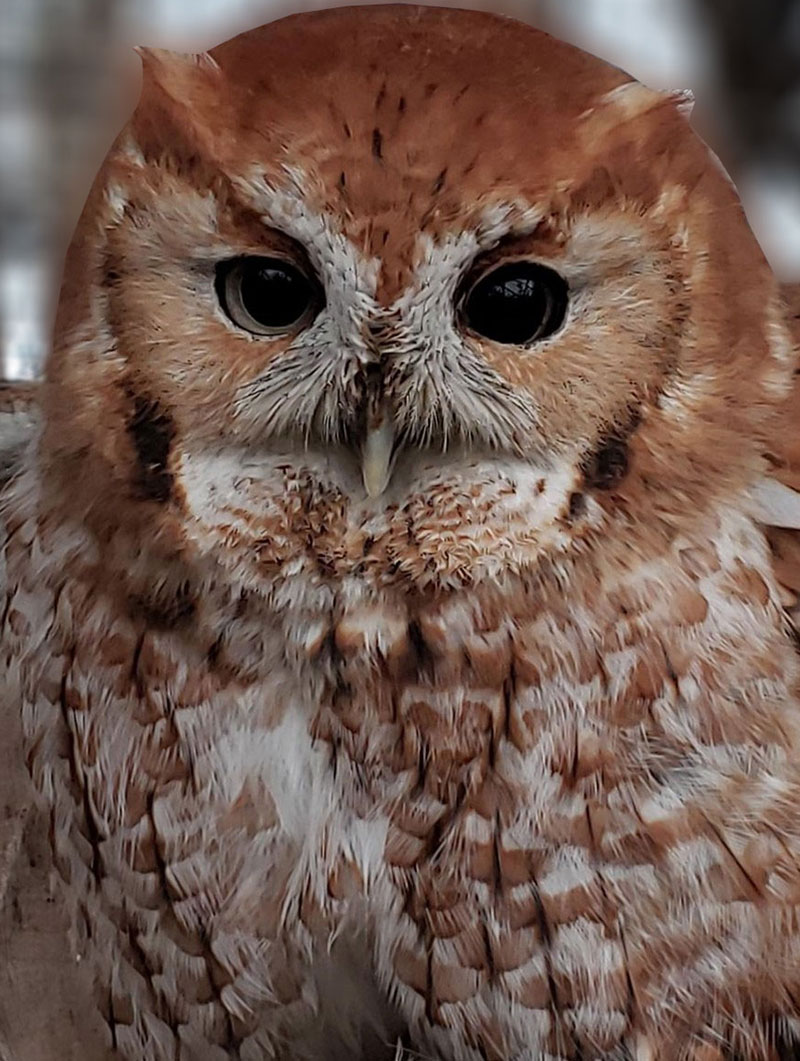Photo by Kmiecik Imagery
Screech Owl
Megascops asio
Description:
A screech owl has a large head with large yellow eyes, a yellow beak, and white eyebrows. It has two tufts on the top of its head that appear to be ears but are really feathers. These owls also have feathered toes. Screech owls can have two different types of coloration, red or gray. These different types of coloring are called phases. The color has no relationship to the age or sex of the owl.
Size:
A screech owl is a small owl that stands approximately 7-10 inches (17.8-25.4 cm) tall and has a wingspan of 18-24 inches (45.7-61.0 cm). It weighs 6 or 7 ounces (170.1-198.4 g). As with other types of owls, the female is generally larger than the male.
Adaptations:
- Screech owls have coloring that allows them to camouflage exceptionally well. When they put their ear tufts straight up and sit very still, they can appear to blend completely into a tree.
- The screech owl has exceptional eyesight in both light and darkness.
- Although its eyes are unable to move in its head, a screech owl can turn its head 270 degrees around in order to see in any direction.
- Like other owls, the screech owl also has a strong curved beak and talons to help it catch its prey.
Diet:
Screech owls have an extremely varied diet and will feed on nearly anything that is smaller than them, including small mammals, birds, reptiles, and insects. Mice and moles make up the majority of their diet. At Cosley Zoo, the screech owls are fed quail, chicken, and mice.
Reproduction:
Screech owls begin nesting in March in natural tree cavities or the abandoned nests of other animals. The female will lay up to five small eggs per clutch (group of eggs). After the eggs are laid, females incubate them while the males guard the nests. Incubation takes an average of 30 days. The eggs generally hatch in the order they were laid, so that all the young are not born at the same time. Chicks begin to fly about four weeks after hatching. Screech owls mate for life.
Shelter and space needs:
Screech owls are found in many different types of habitats, including woodlands, orchards, and backyards with many trees. They avoid dense forests where the great horned owl, one of their major predators, lives.
Life expectancy:
Screech owls have the potential to live 8-10 years in the wild. However, because of high mortality rates for both juveniles and adults, very few of them make it to that age. In human care, their lifespan can be as high as 13 years.
Relationship with man:
As predators, screech owls help to control the populations of pest species including mice and insects.
Fun Facts:
- Screech owls have been known to bring other animals, such as snakes, into their nests to feed on the larval and pupal stages of parasitic insects that infest the nest cavity.
- Contrary to popular belief, the screech owl does not actually screech. It makes more of a trilling sound or a whinny.
- Owls have 14 vertebrae in their necks. This is double the number of vertebrae we have in our necks. These extra vertebrae allow the owl to turn its head up to 270 degrees from its starting point (about ¾ of the way around).
- Owls’ eyes are not round. They have a cylindrical shape which allows them to see well in the dark. Because their eyes are not round, they cannot roll in their sockets as ours can. This is why the owl must turn its entire head to look in another direction.






